
Welcome to all of the new subscribers!
This is the “When I get a round tooit” Creation/Evolution newsletter from Ian Juby and the traveling Creation Science Museum of Canada.
If you do not see a header image above this text, you may have to turn on images in your email program, or you can click here to view it in your browser.
In this “Special Edition” newsletter:
1) Ardi ar arrrr…
2) nuthin’.
No really, that’s it – that’s all that’s going to be in this newsletter!
***********************************************************
1) Ardi ar arrr…
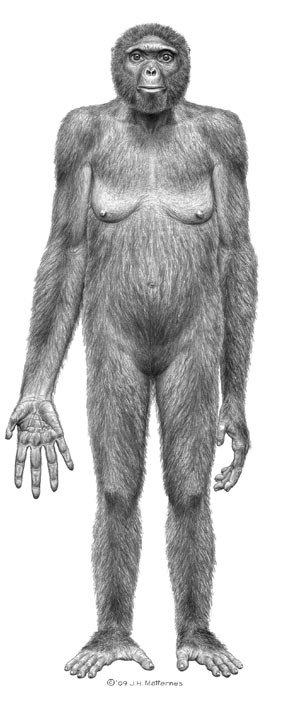 Artist’s best guess as to what Ardipithecus ramidus may have looked like. Okay, so maybe it didn’t stand upright like that, and maybe it didn’t have human eyes like that, and maybe it was a male and not a female, and maybe it….well, it’s close at least! Drawing by J.H. Matternes |
The propaganda machine goes into overdrive:
Got a barrage of emails this week from my honourable news watch team regarding a supposed “Missing link” found this week which “proves” our ancestral relationship to the apes.
In fact, Science magazine even ran a special issue just on this fossil, CBC’s “Quirks and Quarks” devoted a segment of their program to it (downloadable as a 22 meg MP3), National Geographic had a spread on it as well.
Seeing as how there’s been so much fuss over this fossil, I thought I’d devote a newsletter in response.
As is typical, this “missing link” is presented with impressive pomp and circumstance before the emporer comes out wearing no clothes. We’ve seen this before time and again with Ida, Puijila, and even Archaeoraptor – the fraudulent fossil that was brazenly heralded with many bold claims as “proof of evolution” before it was quietly sidelined after it was discovered to be a fake. I still, to this day, occasionally have people bring up Archaeoraptor as proof of evolution. This is the power of propaganda.
Same old, same old.
Before proceeding, it’s probably a good idea to point you to my previous response to the SciAm write up on our supposed “hominid” fossil lineage. In this article, I dealt with dozens of these supposed “half-ape/half-human” fossils that evolutionists often hurl at us: “The Human Pedigree”
1) Start with the assumption that evolution is true.
2) Interpret the fossil within an evolutionary paradigm
3) Use the interpretation as proof that evolution is true.
4) Return to step #1.
The New Old Find
The “new” find (actually found back in ’92) is attributed to Ardipithecus ramidus. The famous ‘flintstone fossil’ “Ardipithecus ramidus kadaba-daba-doooooo!” (thanks Teno Groppi), Ardipithecus has now been divided into two fossils, Ardipithecus ramidus, and Ardipithecus kadaba. Good grief – there was barely enough fossil fragments for one fossil reconstruction, let alone two! See my response to SciAm for more details.
So with the unveiling of more of the fossils this week, once again the evolutionists throw one of the monkeys out of the evolutionary tree! Yup, Lucy got the boot.
| “One effect of chimpanzee-centric models of human evolution has been a tendency to view Australopithecus as transitional between an apelike ancestor and early Homo. Ardipithecus ramidus nullifies these presumptions” “No ape exhibits an even remotely similar evolutionary trajectory to that revealed by Ardipithecus.” |
In other words, what the researchers are saying is that Lucy is not our ancestor. They are claiming that Lucy and her descendants were a line of apes that branched off and went on their own evolutionary trip, and we are not her descendant!
|
Cast of original “Lucy” fossils,
on display at Creation Museum
|
Shown right is a photograph of a cast of the “Lucy” fossils (courtesy of the AIG Creation Museum).
Look veeerrrry closely at the feet and hands. That’s right, they’re missing! Remember that for a second (if you have ADHD like I do, then make a note to yourself, I’ll get you to bring it up in a second).
Stop and look at this for a moment: How many of you have heard of the “Lucy” fossil? Probably the majority of you. It is one of the most well know fossils out there because the evolutionists have parroted it for decades as such good ‘evidence’ that we evolved from an ape-like creature! In fact, on the right (click on the images for higher-resolution images) you’ll see photographs of Lucy reconstructions from the Cleveland museum of natural history, The Chicago Field Museum, and the Michigan State University museum. Lucy is mentioned in probably every natural history museum in North America – that’s how profoundly important the “Lucy” fossil is in the ‘evolution of man’ to evolutionists. In fact, the Cleveland museum actually had an entire display devoted just to Lucy, it was such an important find to them – and to the docent giving the tour there.
Do you now start to see how important this fact is that Lucy just got the boot? The evolutionists are now recanting that this is evidence of our descent from the apes!
Now before we dismember Ardi, take a veerrrrry close look at the “Lucy” reconstructions, and pay especially close attention to the hands and feet. Those of you with ADHD – pull out that note I had you write to yourself a minute ago… if you can find the note now (I know, I lose my notes to myself all the time – note to self: remember notes to self).
Did you notice something? They have depicted Lucy with human hands and human feet (with the exception of the CMNH which at least reconstructed the skeleton with ape-hands, but still with human feet).
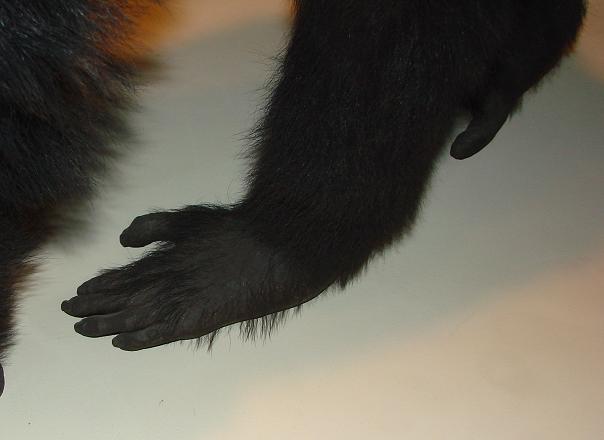
In the Michigan State U. museum, they also depicted her with human eyes – not ape eyes! This has nothing to do with science, and everything to do with propaganda. (see “The Human Pedigree”)
In fact, just recently another A. afarensis (“Lucy” belongs to the afarensis clan) nick-named “Dikika” or “Little Lucy” was found which did have intact foot bones.
Lo and behold, it had the feet of an ape! (gasp!)
(Photo on right, and a special thanks to Dr. G. Charles Jackson for bringing this to my attention)
Such evidence has prompted more than one researcher to remark “A. afarensis almost certainly did not walk like us or, by extension, like the hominids at Laetoli.” [Emphasis mine](Wm. Harcourt-Smith and Charles E. Hilton, Scientific American, 8/2005, p18-9.)
So if all the available evidence shows that Lucy and all of the afarensis had feet like an ape, why then is Lucy portrayed to the public as walking upright like a human, and with feet like a human? The clue comes from Harcourt-Smith’s comment: “…or, by extension, like the hominids at Laetoli.” He was referring to a trail of fossil human footprints found near Laetoli, in Africa, of which the Creation Science Museum of Canada will soon be receiving a cast. Everything about these fossil footprints is human – including a human child stepping in the footsteps of the adult it was apparently following. But, according to the evolutionary timescale, the rocks are “too old” – humans had not yet evolved. Therefore, in the minds of the evolutionists, these footprints must have been made by afarensis.
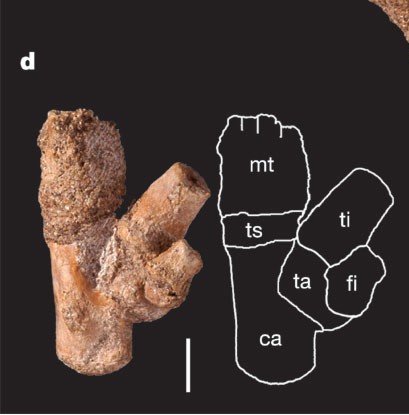 “Dikika” foot bone, this is where the “thumb” of the foot/hand anchors. Clearly the thumb branches off to the side like an ape’s. (Alemseged, et al., Nature 443, 21 September 2006, “A juvenile early hominin skeleton from Dikika, Ethiopia”, pages 296-301) [Errata: Please see this post]
|
Harcourt-Smith and Hilton were quite correct when they said that afarensis could not have made the Laetoli footprints.
Creationist: How do we know those aren’t human footprints?
Evolutionist: Because we do not find human fossils in rocks that old.
Creationist: You just did – fossil human footprints.
Evolutionist: No, those cannot be human footprints.
Creationist: Why not?
Evolutionist: Because we do not find fossil human footprints in rocks that old.
Creationist: Just did.
Evolutionist: No, you don’t understand – they cannot be fossil human footprints – humans hadn’t evolved yet at that time.
Creationist: How do you know?
Evolutionist: Because we only find remains from our ancient, ape-like ancestors in rocks that old.
Creationist: But what about these fossil footprints?
Evolutionist: They must be from our ancient, ape-like ancestors.
Creationist: But they’re completely modern human footprints, and they don’t match the feet of your “ape-like ancestors.”
Evolutionist: They cannot be human footprints, because the rocks they are in are too old.
Creationist: ….Oh…. I see your point. (sigh)
It’s ridiculous circularity!
The evidence didn’t quite line up…
 The other reason Lucy is depicted as standing upright like us is because of her hip. Dr. Owen Lovejoy (one of the researchers writing on Ardi) is already famous to my viewers because of his “research” (snicker snicker) with Lucy. A knee that was found 2-1/2 kilometers away from the rest of the Lucy skeleton, and 70 meters deeper in the rock layers, was used by Johanson (Lucy’s discoverer) and Lovejoy to build the case that Lucy walked upright. In fact, in the PBS NOVA program devoted to Lucy, Owen Lovejoy said he took one look at the first knee and knew instantly “that’s a human knee.” (quote and screenshot from NOVA/PBS/WGBH, “In search of human origins,” Episode 1, “The story of Lucy,” 1994)
The other reason Lucy is depicted as standing upright like us is because of her hip. Dr. Owen Lovejoy (one of the researchers writing on Ardi) is already famous to my viewers because of his “research” (snicker snicker) with Lucy. A knee that was found 2-1/2 kilometers away from the rest of the Lucy skeleton, and 70 meters deeper in the rock layers, was used by Johanson (Lucy’s discoverer) and Lovejoy to build the case that Lucy walked upright. In fact, in the PBS NOVA program devoted to Lucy, Owen Lovejoy said he took one look at the first knee and knew instantly “that’s a human knee.” (quote and screenshot from NOVA/PBS/WGBH, “In search of human origins,” Episode 1, “The story of Lucy,” 1994)
Question: What if it IS a human knee? Well that would mean that humans were around in rocks older than Lucy, and as we just saw in our discussion with our evolutionist, we do not find human remains in rocks so old – so obviously the knee must’ve come from Lucy! This is the circular logic of the evolutionist.
The problem was though, the hip that was found with the Lucy skeleton was too chimp-like to permit Lucy to walk upright. Whatever is an evolutionist to do?
Simple: Just call in Lovejoy – he and his dremel can fix any problem.
That’s right, Lucy’s hip had been broken into about forty pieces when they found it. So Lovejoy made a cast of each piece, then took a grinder to the pieces to reassemble the hip into a more human-like shape!
See “Complete Creation” part 16, viewable on line for free on the CompleteCreation.org website to see it for yourself. Better yet, get a copy of the NOVA program.
Problem solved: If the fossil doesn’t look half-ape/half-human, make it look half-ape/half-human.
Lovejoy was a former forensic scientist. That’s right – a CSI. Can you imagine if he brought such evidence to court?
Lawyer: Let me get this straight again Dr. Lovejoy, where did you find the evidence?
Lovejoy: We found it buried underneath 70 meters (230 feet) of undisturbed dirt, roughly 2-1/2 kilometers away from the crime scene.
Lawyer: And how do you know this ‘evidence’ has anything to do with the crime at hand?
Lovejoy: Uhhh… because it looks a lot like the evidence at the crime scene?
Lawyer: And you did WHAT to the evidence you found at the crime scene itself?
Lovejoy: Well, we know that the defendant is guilty, see? So even though the evidence didn’t point to him being the culprit, we felt we were quite justified in taking a dremel to modify the evidence to fit what we already knew. So as you can see, after we scientifically altered the evidence, you’ll see that it matches exactly what we were looking for at the crime scene, which proves the defendant guilty.
Judge: Say again?
Lawyer: ….Oh. I see your point.
Can you imagine how fast such evidence would be thrown out of court – with Lovejoy following it shortly thereafter, landing on his keester? It’s amazing what such people think they can get away with by pasting “scientific” in front of what they do!
This is certainly not scientific, it can hardly be called honest!
Ardi’s hip:
So now Lovejoy puts in his interpretation of Ardi’s hip as well. Do I trust Lovejoy et. al’s interpretation? Nope – not as far as I can thrown him – especially in light of what’s been done in the past. Does that mean that Lovejoy is wrong here? No.
Even a broken clock is right twice a day, and it’s important to examine the evidence to determine the truth.
Like Lucy, Ardi’s pelvis was found badly crushed – yet there was much interpretation made of the hip. It was supposedly ape-like in the lower part of the pelvis, yet more human-like in the upper portions. The claim is that this allowed Ardi to walk a little more like a human a little less side-to-side lurching like apes do.
First, this doesn’t in any way show anything but an ape. And even then, the evidence for bipedality is pretty sketchy to say the least. This is an interpretation, not observation – we weren’t there to see how Ardi walked, so it’s an edumicated guess at best. William Jungers of Stoney Brook U.is not at all out of line in saying “This is a fascinating skeleton, but based on what they present, the evidence for bipedality is limited at best.”
Ardi puts a foot forward.
But Ardi’s foot is fairly well preserved… and it is very obviously a flat-footed ape’s foot – complete with curved toe bones, best suited for grasping branches:

From Science 326, 72 (2009), “Combining Prehension and Propulsion: The Foot of Ardipithecus ramidus,”
C. Owen Lovejoy, et al.
Okay, so nothing un-ape-like about it so far; in fact, it is very ape.
Ardi’s secret sex life:
Once again (no, this isn’t the first time I’ve seen evolutionists attempt this!) you can see the stretch the evolutionists take in that they even interpret the sex lives from the fossil! Now how on earth can you deduce the sex lives of this creature by looking at its remains? Well by its teeth of course! As the National Geographic article explains:
| One provocative answer to that question—originally proposed by Lovejoy in the early 1980s and refined now in light of the Ardipithecus discoveries—attributes the origin of bipedality to another trademark of humankind: monogamous sex. Virtually all apes and monkeys, especially males, have long upper canine teeth—formidable weapons in fights for mating opportunities. But Ardipithecus appears to have already embarked on a uniquely human evolutionary path, with canines reduced in size and dramatically “feminized” to a stubby, diamond shape, according to the researchers. Males and female specimens are also close to each other in body size. Lovejoy sees these changes as part of an epochal shift in social behavior: Instead of fighting for access to females, a male Ardipithecus would supply a “targeted female” and her offspring with gathered foods and gain her sexual loyalty in return. |
In other words, because we observe that modern male humans don’t bite each other anymore as they fight to convince a female to mate with them (aren’t you glad ladies?), and because this ape’s teeth are ‘less vicious,’ it must prove that this ape walked upright, and therefore this ape is in our lineage between apes and humans.
I’m going to leave out all the puns that come to mind here, but I do have a bone to pick with the researchers (pun intended). In all their wild speculations (!!!) about the sex lives of these creatures, based on bones, the evolutionists never seem to mention the difference between male apes and human males when it comes to sexual reproduction. Male apes have a penis bone for rigidity, male humans have a hydraulic system. I’ll let you figure it out, but let me just point out that the male and female reproductive systems have to work – the first time, every time, and the two systems must be 100% compatible or it’s the end of the species! Even if there was a certain blue pill with a name starting with “V” (I can’t name it, lest this newsletter make the spam blockers go balistic) in Ardi’s time, unless you’ve got the control systems built into the male reproductive system, I’m afraid blue pills won’t do you a bit of good!
So how then did evolution change the reproductive system from a mechanically rigid system to a hydraulic system, without terminating the species? Hmmm?
That’s usin’ yer head:
If you head on over to my article on “The Human Pedigree”, you’ll already be aware of the importance of the differences between the skulls of humans and of apes. Welp, what little remains there are of Ardi’s skull are completely ape-like (gee, anybody detecting a pattern here?). The foramen magnum is the hole in the base of the skull where the spinal cord enters. In apes, this angles back, whereas in humans, it’s straight up and down and located farther forward on the skull, because we walk upright. Obviously the position and angle of the foramen magnum is important to an evolutionist. In what few afarensis remains we have, we can determine that the foramen magnum is clearly ape-like.
With Ardi, there wasn’t enough of the skull to make any determination. You need to realize something though – there was lots of bones at the Ardi site. Rather, I should say, bone fragments. By the researcher’s own count, they estimate they dug up fragments of some 35 different Ardi specimens, and they picked 125 fragments out of an estimated 230 or so. This isn’t to mention the hundreds of bone fragments from different animals that were also found.
So one immediately has to ask the uncomfortable question: “How do we know that the bones they have assigned to Ardi really did belong to Ardi?” The short answer is that we don’t. We’ve already seen how the evolutionists reject even the notion that there may be human fossils there, so if they found a fossil fragment from a human, they would assume it belonged to Ardi.
In other words, they may have assembled a genuine half-ape/half-human fossil by mixing human and ape fossils together.
Further to that, when the research paper itself starts off with the words “The highly fragmented and distorted skull of the adult skeleton ARA-VP-6/500…” (“The Ardipithecus ramidus Skull and Its Implications for Hominid Origins”, emphasis mine) you know there’s only so much you can interpret from the skull. In fact, just read the first two pages of that article, and you’ll see it emphasized just how bad a shape the skull was in.
Bearing this in mind, it’s of great interest that the researchers were missing some crucial pieces of the skull. But they had found similar pieces nearby, but they were from a skull the wrong size. It is assumed that these pieces were from a larger Ardi, and so the pieces were scanned in a CT scanner, reduced in size on the computer, and fitted digitally to the other pieces they had.
Now I’m not opposed to this technique, nor am I saying that they are wrong – but understand here: These pieces were not part of the skull in question – and in fact these pieces are so fragmentary that one really can’t determine what kind of creature they’re from. They could even be from a human for all we know. I am only saying that there is huge room for major errors and subjective interpretation here.
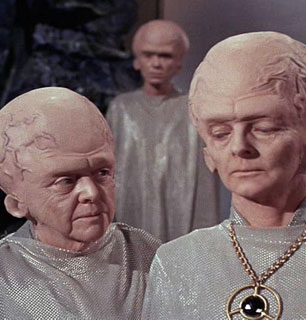 Now the researchers did not tout the usual claims about how the position of the foramen magnum shows that it walked upright – instead, they focused more on the position of the skull pieces in determining cranial capacity, or brain size. Brain size is also important to evolutionists because in their mind (pun intended) a bigger brain means more intelligence, and would mean the creature is more human like.
Now the researchers did not tout the usual claims about how the position of the foramen magnum shows that it walked upright – instead, they focused more on the position of the skull pieces in determining cranial capacity, or brain size. Brain size is also important to evolutionists because in their mind (pun intended) a bigger brain means more intelligence, and would mean the creature is more human like.
This is flimsy evidence to say the least – apes have tremendous variation in brain size, and so do humans, and their brain sizes can overlap.
The conclusions of the researchers were also based partly on other “hominid” skulls, of which those interpretations are rather questionable as well! For example, the tchadensis skull was badly crushed – even the evolutionists themselves admit this made interpretations of the skull difficult and questionable. So you simply cannot use questionable interpretations of other skulls to bolster the questionable interpretations of the present skull!
How old is that fossil in the layer?
Of course, the “age” of the fossil is important in the evolutionary interpretation, and in this case, the fossils were apparently sandwiched between two volcanic layers – perfect for dating by various “scientific” dating methods.
Ya, well, we’ve seen this before: In his book “bones of contention,” Lubenow does a splendid job of documenting the dating surrounding the skull known as 1470. I spent almost all of the entire 1/2-hour video, part 21 of the “Complete Creation” series, showing just how reliable these supposed “scientific” dating methods are. That video is, of course, available for viewing for free on the internet.
We aint finished yet…
This is only a preliminary report, to get it out to y’all as quickly as possible, to stay on top of the game. I’m quite certain there’s going to be much more to report on later on. I’ve only taken a cursory look at the articles – there’s 11 of them in Science alone, so there’s much more meat to be digested from it all.
**************************************************************
These newsletters typically represent 20 to 40 hours worth of work. Help keep them coming by considering making a donation to Ian’s work.
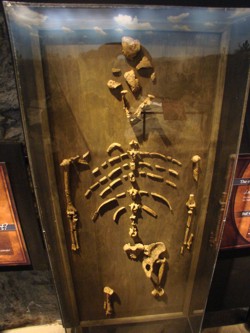
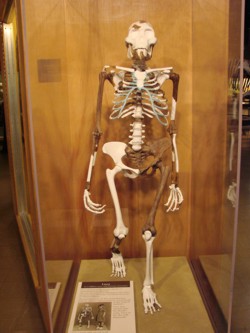
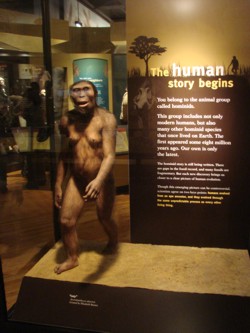


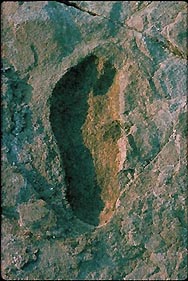




Trackbacks/Pingbacks